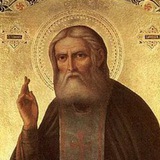Orthodoxie
17 декабря 2023 11:49
Sainte Barbara
@
Читать полностью…
Orthodoxie
15 декабря 2023 17:25
Église dans la région de Saint-Petersbourg
@
Читать полностью…
Orthodoxie
15 декабря 2023 17:22
Église dans la ville de Saratov
@
Храм иконы Божией Матери «Утоли моя печали», г. Саратов
Каменная шатровая церковь на трех рядах кокошников с двумя симметрично расположенными притворами удачно вписалась в застройку архиерейской усадьбы и в архитектурный ансамбль центра Саратова. Изюминка архитектурного решения в том, что крупный шатёр окружён многочисленными пёстро разукрашенными мелкими главками, видимо, в подражание собору Василия Блаженного в Москве.
Архитектор: Пётр Зыбин
Дата постройки: 1904-1906 годы
Читать полностью…
Orthodoxie
13 декабря 2023 17:35
Saint apôtre André
@
Читать полностью…
Orthodoxie
13 декабря 2023 14:17
Saint apôtre André
@
Читать полностью…
Orthodoxie
12 декабря 2023 15:30
Saint prince Alexandre Nievsky
@
Читать полностью…
Orthodoxie
04 декабря 2023 21:45
@
Читать полностью…
Orthodoxie
04 декабря 2023 21:04
@
Читать полностью…
Orthodoxie
30 ноября 2023 10:11
Saint Grégoire le Thaumaturge, évêque de Néocésarée (+270)
@
Читать полностью…
Orthodoxie
30 ноября 2023 07:20
Апостол и евангелист Матфей
Читать полностью…
Orthodoxie
29 ноября 2023 19:37
Holy Apostle Matthew the Evangelist
Saint Matthew was a tax collector when the Lord saw him and said: Follow Me. Matthew repented of his sins, recompensed fourfold those he had overcharged, gave his remaining possessions to the poor, and followed the Savior. Matthew witnessed Christ's innumerable miracles and His suffering, death, and Resurrection and beheld His glorious Ascension into Heaven. Having received the grace of the Holy Spirit at Pentecost, he spent eight years preaching the Gospel in Palestine. At the request of the faithful in Jerusalem, Matthew wrote his account of the earthly life and teachings of the God-man Jesus Christ. Matthew brought the Good News to Syria, Media, Persia, Parthia and finally Ethiopia, where he built a church and appointed his follower Plato as bishop. When Matthew baptized the wife and son of the prince of Ethiopia, the enraged ruler put him to death. But after witnessing the miracles surrounding the Apostle's martyrdom, the prince was baptized and took the name Matthew.
Читать полностью…
Orthodoxie
26 ноября 2023 15:00
Saint John Chrysostom
John was born in Antioch in 354. His father was an imperial commander. Studying philosophy, John became disgusted with paganism and adopted the Christian Faith as the one and all-embracing truth. He was baptized and his parents soon followed him in the faith. He was tonsured a monk and lived a life of asceticism. The Apostles John and Peter appeared to him, foretelling his life of great service and suffering. He was ordained and a shining dove was seen over his head. He was chosen as Patriarch of Constantinople by Emperor Arcadius and governed for six years with unequalled zeal and wisdom. He sent missionaries to the pagans, eradicated simony, shamed heretics, increased charitable works, wrote a Divine Liturgy and gave us many precious books of homilies. The people glorified him, the envious hated him, and the Empress exiled him. John spent three years in exile, reposing on the Feast of the Elevation of the Cross in Georgia in 407. His last words were "Glory be to God for all things.''
Читать полностью…
Orthodoxie
25 ноября 2023 09:13
Saint apôtre Paul
@
Читать полностью…
Orthodoxie
21 ноября 2023 17:18
Synaxe de l’Archistratège Michel et les autres puissances incorporelles
@
Читать полностью…
Orthodoxie
14 ноября 2023 07:57
Holy King Stefan Milutin
A great son of the Orthodox Church, King Milutin rose up decisively against Emperor Michael Paleologos to stop an enforced union with Rome and with God's help saved Orthodoxy - not only in his own land of Serbia, but in all the Balkans. All his wars were successful, for he constantly prayed to God and hoped in God. When Milutin ascended the throne, he vowed that he would build a church for each year that he reigned and so he built 42 churches and several monasteries. Next to the churches he built hospitals for the indigent, where the poor would receive care for free. He especially loved to give alms to the needy from his own enormous wealth. The powerful and wealthy king would dress in the clothes of a poor man and walk among the people and ask about their misfortunes, and gave to them abundantly. Saint Stefan Milutin entered eternal life in 1321 and his body was soon discovered to be incorrupt and miracle-working and remains today in the Church of the Holy King in Sofia, Bulgaria.
Читать полностью…

 288
288